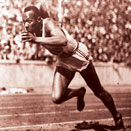

Race and Sports ‘Black athletic superiority’
Courtesy of Wikipedia
“Black athletic superiority” is the belief by some people that Black people possess certain traits that are acquired through genetic and/or environmental factors that allow them to excel over other races in athletic competition. Whites are more likely to hold these views; however, some Blacks and other racial affiliations do as well. A 1991 poll in the United States indicated that half of the respondents agreed with the belief that “Blacks have more natural physical ability”. Thus, the notion of “Black brawn vs. white brains” is prevalent in sports commentary in the United States.
However, Blacks don’t dominate all areas. In “pure brawn”, such as strongman, whites consistently dominate. It seems, as a general rule, that whites are better at strength and Blacks are at speed.
Various theories regarding racial differences of Black and white people and their possible effect on sports performance have been put forth since the later part of the nineteenth century by professionals in many different fields. In the United States, attention to the subject faded over the first two decades of the twentieth century as Black athletes were eliminated from white organized sport and segregated to compete among themselves on their own amateur and professional teams. Interest in the subject was renewed after the 1932 Summer Olympics in Los Angeles and Jesse Owens’s record-breaking performances at the 1935 Big Ten Track Championships.
In 1971, African-American sociologist Harry Edwards wrote: “The myth of the Black male’s racially determined, inherent physical and athletic superiority over the white male, rivals the myth of Black sexual superiority in antiquity.”
Jon Entine has argued, most prominently in his book Taboo: Why Black Athletes Dominate Sports and Why we’re Afraid to Talk about It, that body type and physiology are shaped by evolution and can be correlated, somewhat loosely, to skin color. He claims that Africans from different parts of the continent have different body types and on average, excel in different sports.
For example, Kenyans have won most of the cross-country races for the better part of thirty years, and East Africans who trace their ancestry to areas along the Rift Valley dominate endurance running. East Africans have a higher percentage of slow-twitch fibers in their muscles, a slightly longer body, longer legs, and larger lung capacities which help in endurance and long-distance running.
Conversely, Western African-descended runners dominate in anaerobic sports, including sprinting. People with ancestral roots in this region of Africa have bigger, more visible muscles along with a higher number of fast-twitch fibers in their muscles. They also have less natural body fat, narrower hips, and higher levels of testosterone. Anthropologist Ian Kerr criticized Entine’s hypothesis, stating that biological variation cannot be used to uphold claims of racial superiority in athletics.
Joseph L. Graves argues that Kenyans and East Africans who have done well in long distance running all have come from high-altitude areas, whereas East Africans from low-altitude areas do not perform particularly well. He also argues that Koreans and Ecuadorians from high-altitude areas compete well with Kenyans in long-distance races. This suggests that it is the fact of having trained in a high altitude, combined with possible local level physiological adaptations to high-altitude environments that are behind the success in long distance running, not race.
Similarly, Graves argues that while it is superficially true that most of the world record holders in 100-metre dash are of West African heritage, they also all have partial genetic heritage from Europe and Native America, they have also all trained outside of West Africa, and West African nations have not trained any top-level runners. Graves says these factors make it impossible to say to which degree the success is best attributed to genetic or to environmental factors.
John Milton Hoberman, a historian and Germanic studies professor at the University of Texas at Austin, has acknowledged that disparities in certain athletic performances exist. He has asserted that there is no evidence to confirm the existence of “Black athletic superiority”.


Be the first to comment